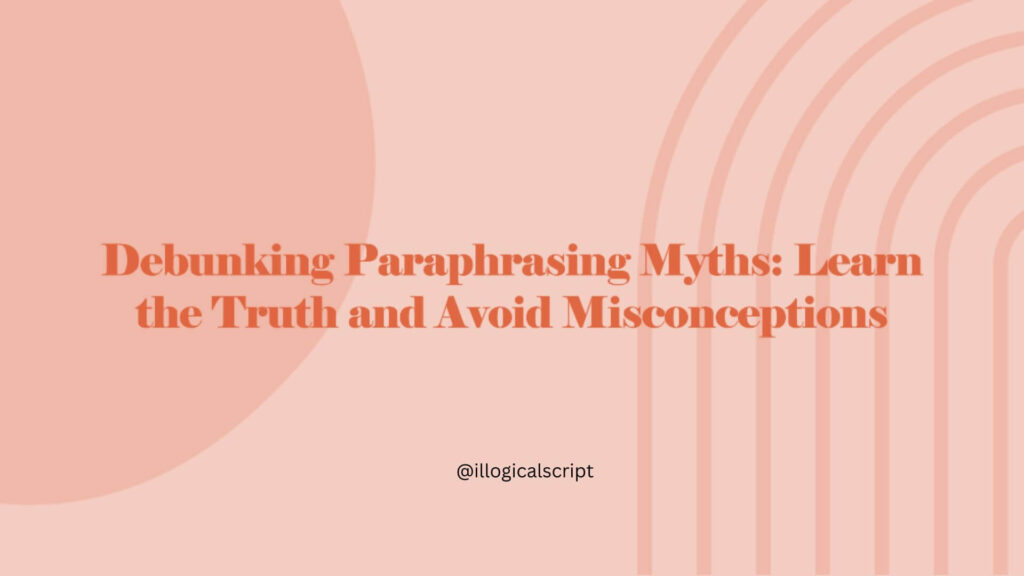If you have ever written content in any shape or form, you might have heard about the term Paraphrasing. The meaning of this term is so simple, yet so many people seem to misunderstand it.
Paraphrasing can be used for various purposes, but there are some ethical considerations that you have to keep in mind. Other than that, there are also some myths about this technique’s usage that we are going to clarify.
What is Paraphrasing?
To clear any sort of confusion, we are going to start from scratch. The definition of paraphrasing can simply be stated as follows:
“Restating written content in a different way and maintaining its original meaning.”
An example of this is as follows:
- Original: The Internet has revamped the way of communication.
- Paraphrased: The Internet has transformed the method in which we communicate.
Both sentences are written differently but have the same meaning. This is how paraphrasing essentially works.
Myths About Paraphrasing
Now that you are familiar with what paraphrasing actually is, let’s talk about a few misconceptions that you might have had about it.
1. Paraphrasing is Simply Changing a Few Words in the sentence:
Many people think that replacing words with other words with similar meanings is all there is to paraphrasing. This myth restricts the actual meaning of paraphrasing, which can be done in a lot more ways than just changing a few words.

Here is an example to show why and how this is incorrect:
- Original; Climate change is due to the large amounts of smoke coming out of industrial factories.
- Paraphrased: Climate change is because of massive amounts of smoke emitted from industrial factories.
According to this myth, this is the only correct way to paraphrase this sentence. However, it could also have been paraphrased as the smoke coming out of industrial factories is the reason for climate change. If you pay attention, there are much more modifications in this version other than simple word replacement.
2. Paraphrasing Doesn’t Require Citation or Referencing
This has to be the most common myth about paraphrasing. A majority of people think that simply stealing someone else’s ideas and rephrasing them as your own makes you the original author.
This is a false misconception. It causes a number of different write-ups to get plagiarized and even penalized in some cases.
No matter how much you rephrase written content, you have to make sure that the original author or source is cited. Even if you have just taken an idea from someone else’s content, it is advised to accredit them to avoid any complications.
3. Paraphrasing is a Quick and Easy Process
Many people think that paraphrasing is a simple process and doesn’t require much thinking. While this might be true for some cases, it can be completely false in others.
For instance, the example we used to explain the definition of paraphrasing was a really basic form of paraphrasing. But if you were to paraphrase a highly complex sentence, you would have to think a lot harder. Such a complex sentence is given in the example below:
- Quantum entanglement and the probabilistic behavior of subatomic particles defy determinism, opening doors for transformative progress in quantum computing and communication.
Paraphrasing this sentence while maintaining its meaning and intent is a really complicated task.
Realities of Paraphrasing
The misconceptions have been cleared out, and now we will move on to the actual facts about paraphrasing.
1. Paraphrasing Requires Understanding and Interpretation
You can not blindly replace words with their synonyms and expect a write-up to be correctly paraphrased. Sometimes even the replacement with the most closely matched words can alter the meaning of a sentence.
That’s why it is very important to first analyze the meaning of a sentence before paraphrasing it. If the sentence that you want to paraphrase is in between other sentences, then you also have to understand the contextual meaning of it.
Once you fully understand the intent of the written content, you can effectively rephrase it. Otherwise, this is what happens:
- Original: The moonlight shimmered on the calm lake, creating a captivating reflection.
- Paraphrased: The moonlight blinked on the self-composed lake, creating bewitching thoughts.
If you look closely, the meaning of replaced words is closely matched, but the second sentence is completely different from the first.
2. Paraphrasing Requires Proper Citation and Referencing
As discussed before as well, paraphrased content doesn’t become original. If the idea is taken from somewhere else, then citation is absolutely necessary. An example of this is given so that you can understand.
Let’s suppose you shared a statistic from another source in your writing. Here is the statistic that we are taking as an example:

Since you didn’t personally study and come up with this statistic, you will have to cite it even after you paraphrase it. One way of adding this stat to your content is as follows:
The AI-Powered content market is expected to exceed $250 Billion in worth by 2022.
In this example, the source has been cited with the help of a hyperlink. You can also cite it as a separate html or follow some other proper referencing method.
3. Paraphrasing Involves Rewriting Text in Your Own Words
If we forget about all the technical aspects of paraphrasing, the simple way to explain it would be rewriting something in your own words. Here are some tips for putting a written piece of content in your own words.
- Re-arrange sentence components.
- Alter the voice of sentences to shift the focus to different parts.
- Make use of punctuation.
These are just some basic tips. You can choose any way of rewriting as long as the original meaning stays preserved.
Strategies For Effective Paraphrasing
Now that we have cleared the myths and realities about paraphrasing, we will talk about some effective techniques. If paraphrasing was not what you thought it was, then you should consult the following sections. They will help you understand how you can truly paraphrase something.
1. Read and Understand the Original Text Thoroughly
As we have said repeatedly, the original meaning of the sentence cannot be disturbed by paraphrasing. That’s the reason why accurately understanding the intent and meaning of the sentence is crucial.
Here are some tricks that you can use if you are having difficulty understanding the meaning of a sentence.
- Read the sentence backward
- Read the sentence out loud.
- Read the previous and subsequent sentences to understand the contextual meaning.
2. Identify the Main Points and Key Ideas to Paraphrase
Once you know the exact meaning of the sentence, the next step is to identify its main points. For example, here is a sentence:
- The dog was barking loudly because a stranger was trying to enter the house.
In this sentence, there is a dog. It is barking loudly. And it is doing so because a stranger is trying to enter the house. These are the main parts of this sentence, and you can use them to paraphrase.
If we want to paraphrase the above sentence, it can be done as:
- The dog was barking vigorously because an unfamiliar person was trying to break into the house.
In this example, we changed words from all the main parts of the sentence. However, even if you made changes to two or even one key point of the sentence, it would’ve been effectively paraphrased.
3. Make Use of Online Technology
We have already explained the manual or traditional method of paraphrasing. However, nowadays, a new approach is being utilized. There are number of various online tools that allow you to paraphrase online free.
To use these tools, you won’t have to undergo the pre-processing steps of paraphrasing that are mentioned above. They paraphrase your given sentences within seconds and also maintain the original meaning.
Here is an example of how an AI-driven paraphrasing tool rephrases a given sentence:

Consequences of Improper Paraphrasing
If you keep believing the myths about paraphrasing and ignore the above strategies, then you might have to face adverse consequences. Two of the major effects that improper paraphrasing can have are given in the following:
1. Academic Consequences
Students that are familiar with the concept of paraphrasing are using this technique unethically. They tend to show zero effort and rely on other people’s work. Students are increasingly committing paraphrasing plagiarism. It is having largely negative impacts on their academic performance.

Some advanced schools have strict plagiarism policies. But the students who don’t get caught are the real victims. They realize that they haven’t studied anything. This results in them failing exams and poor overall academic performance.
2. Professional Consequences
Improper paraphrasing can have a huge impact on the credibility of professional businesses. It is extremely crucial that professional documents cite relevant sources and paraphrase the sentences without altering their meaning.

Because of document sensitivity in professional matters, the probability of improper paraphrasing detection is also quite high. That’s why you should be highly cautious when paraphrasing for professional purposes.
Final Words
Clearing out any confusion related to paraphrasing is very important, as it can have some serious effects. That is why we have created this extensive article to help you understand the real meaning of paraphrasing and how it can be done. We hope that now you won’t be using paraphrasing for reasons that have become popular due to false myths.
Also Checkout Some of The Mentioned Articles Below:




